Red is the East in Taking Tiger Mountain by Strategy
In scene 6 on Tiger Mountain, main hero Yang Zirong hears the melody of Red is the East and is immediately reminded of his comrades. Deliberating the happy hopes of the impending battle, his feelings rise up in a long melisma (Zhiqu weihushan 1971:282). In antiphon with the woodwinds, an instrumental group often used to mark idyllic situations in both Western and Chinese musical iconography, he sings of the Chinese Communist Party which “warms his heart and gives him hope.” After a long melisma on “the Glory of Mao Zedong Thought,” supported again, musically, by rising wind passages, he relates that he is about to send off his message.
Suddenly, for one bar, the musical scene changes drastically. The strings are silent, and only the low winds, the trombone, horns and bassoons as well as the mouth organ sheng 笙 play the chromatic leitmotif of the bandits, which, in its original, has an ambitus of an augmented fourth, the interval also called diabolus in musica. Yang, aware of the danger around him, now decides to send his message off quickly in order not to “let the people and Party down.”
On the word “Party”, the top-note of the aria, he sings a long melisma before he continues that “standing in the cold and melting the ice and snow, I’ve the morning sun in my heart” 我胸有朝阳. Into the long sustained note on “sun,” the orchestra cites the line “China has brought forth a Mao Zedong” from Red is the East. The phrase culminates into a rising glissando in strings and winds concluding with the spheric sounds of the chimes and Mao’s apotheosis in musical terms is further underlined by Yang’s wide-open shining eyes and the reddening of the sky in the background (ill. 2.6a&b, ibid.:309/310, cf.ill. 1.6).





































